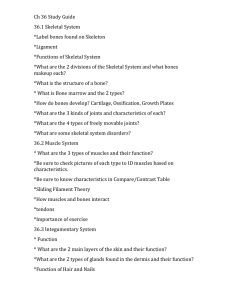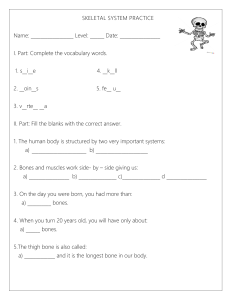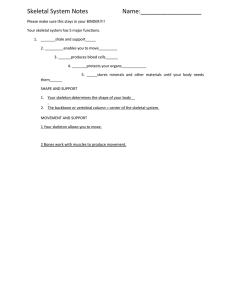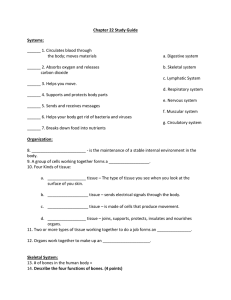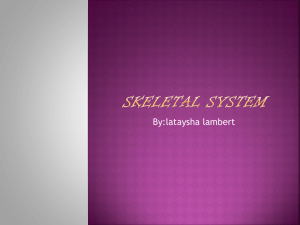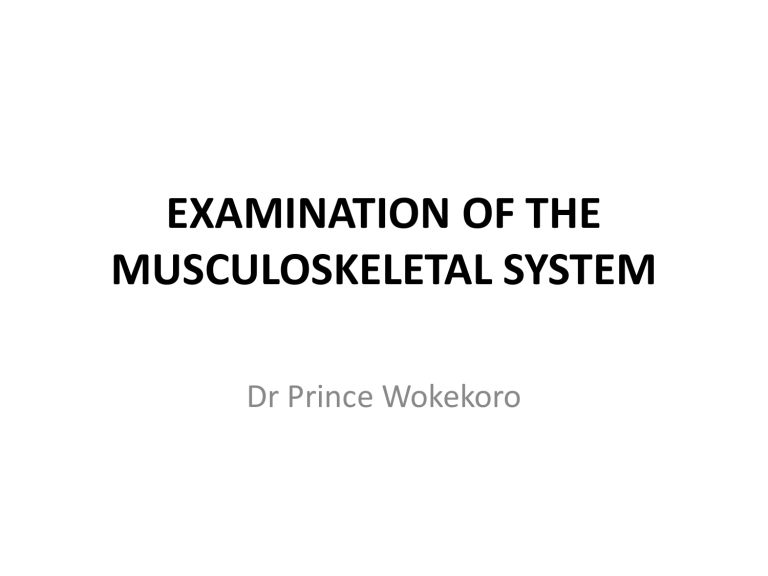
EXAMINATION OF THE MUSCULOSKELETAL SYSTEM Dr Prince Wokekoro The musculoskeletal system (locomotor system) is an organ system which enables the body (an organism) to move, support itself, maintain stability during locomotion as well as maintain its shape It is subdivided into two broad systems: Skeletal system Muscular system Functions of the MSS Provides Shape /form Stability Support . Movement Skeletal system Main component is the bone. Axial Appendicular Axial skeleton Includes the bones along the long axis of the body. The axial skeleton consists of the Vertebral column Bones of the head and Bones of the thoracic cage . Appendicular skeleton Includes the bones of the shoulder and pelvic girdle Bones of the upper and lower extremities Skeletal system Bones articulate with each other to form the joints The integrity and function of the bones and joints is supported by the accessory structures of the skeletal system; Articular cartilage Ligaments Joint capsule Bursae Skeletal system Bones: Mechanical basis for movements Providing framework for the body Vital organs protection Blood cells production Storage of minerals Skeletal system The skeletal system plays an important role in other homeostatic functions such as Storage of minerals e.g. calcium,phosphate and Hematopoiesis Muscular system Includes all types of muscles in the body. Skeletal muscles, in particular, are the ones that act on the body joints to produce movements. Tendons attach the muscles to the bones. Stores the majority of the body's carbohydrates in the form of glycogen. Muscles: Movement production Joint stabilization Maintaining posture Body heat production Clinical correlation • A variety of conditions can affect the muscles,bones and joints • They can be: Degenerative Metabolic Congenital Neurologic Traumatic Infective Autoimmune Nutritional Malignant vascular Musculoskeletal Diseases Primary symptoms of the musculoskeletal disease include Pain Stiffness Swelling Limited range of motion, Weakness Fatigue and Decreased physical function. Diseases involving MSS Muscular • Muscle Dystrophy • Muscle atrophy • Myasthenia gravis • Sarcopenia • Lupus erythematosus • Pyomyositis Skeletal • Arthritis: Osteoarthritis Rheumatoid arthritis • Rotator cuff tear • Tendonitis • Bursitis • Carpal tunnel syndrome • Osteomalacia/osteoporosis • Fractures • Dislocations • Osteomyelitis Examination of MSS • • • • • • • • Site of lesion Size and extent of involvement of lesion Nature of lesion Movement of joint Loss of function Any swelling ? Any tenderness ? Correlate disorder of MSS with the clinical picture Examination of the locomotor system Same Clinical Assessment Format or sequence applies,ie Inspection Palpation GALS-Brief and sensitive in detecting locomotor disorders that may lead to disability. Gait Arms Legs Spine Examination of the locomotor system • • • • Check for swelling, deformities,limb shortening Inspect for ulcers or any lesion Any muscle wasting ? Check for movements across joints,note if there is crepitus • Palpate for warmth and tenderness Further Reading • https://www.kenhub.com/en/library/anatomy/themusculoskeletal-system • Overview of the Musculoskeletal System. (2020, August 14). https://med.libretexts.org/@go/page/7455 • https://www.verywellhealth.com/the-musculoskeletalsystem-what-is-it-189651 • Hutchison’s Clinical method
